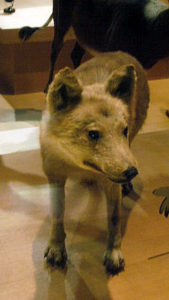 According to graduate student Jonas Niemann of the University of Copenhagen, studying the DNA of the Honshū wolf could hold important clues on the evolution of dogs. While most ancient wolves died off about 35,000 years ago, Niemann says that this species of wolf lived in Japan until about 1905 when farmers poisoned them after domesticated dogs introduced rabies to the population of wild wolves. In fact, organized hunts involving all levels of society were regularly held to get rid of these wolves who people became afraid would attack people in cities because of rabies.
According to graduate student Jonas Niemann of the University of Copenhagen, studying the DNA of the Honshū wolf could hold important clues on the evolution of dogs. While most ancient wolves died off about 35,000 years ago, Niemann says that this species of wolf lived in Japan until about 1905 when farmers poisoned them after domesticated dogs introduced rabies to the population of wild wolves. In fact, organized hunts involving all levels of society were regularly held to get rid of these wolves who people became afraid would attack people in cities because of rabies.
Trusted Allie
The Honshu wolf was once trusted by farmers because they would warn farmers of wild boars. Now, all that remains of this species are a few preserved species like the one that Niemann studied at the Natural History Museum in London. Some argue that this specimen was the last of its kind. Zoologist Malcolm Anderson of the museum had gone to Japan to collect rare animal species when two men approached him with this wolf who they claim to have shot two days before. Anderson brought the wolf back to the museum where it has been on display since 1905.
DNA Taken From Last One
Researchers have long believed that the Honshu species of wolf originated in Siberia before making its way to northern Japanese islands where it lived for several years before migrating even further south. They have also held that the wolf studied was the last of its species, but some have reported seeing the species alive in remote areas of Japan ever since the last one was supposedly killed.
Description of the Honshu Wolf
This wolf was the smallest in the world standing just about 30 centimeters at the shoulder. They had shorter legs compared to the length of their bodies than the more common gray wolf. They also had a more rounded tail similar to those found on many species of dogs today like the boxer.
Paleogeneticist Mikkel Sinding of the Greenland Institute of Natural Resources in Nuuk believes that the collection of this DNA may hold important clues on the evolution of dogs and wolves. Others believe it may be the missing link connecting the two types of animals together.


